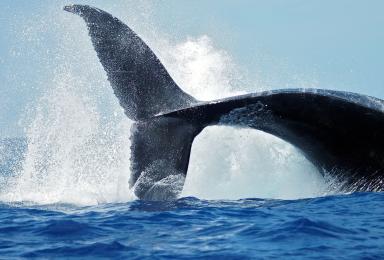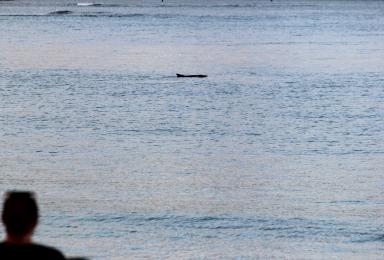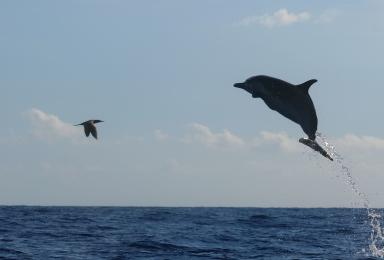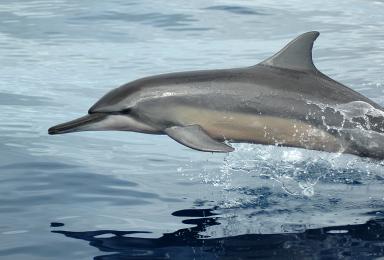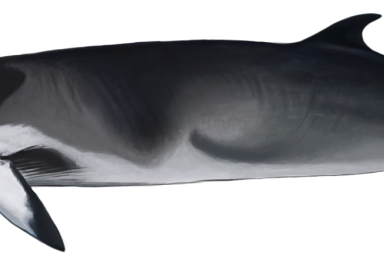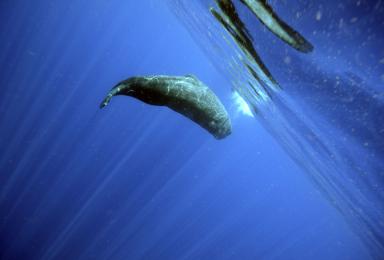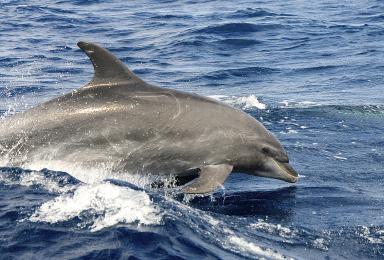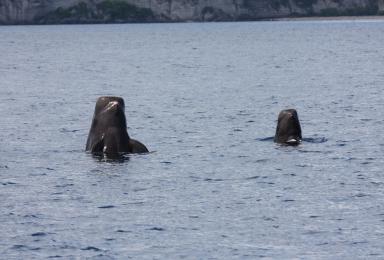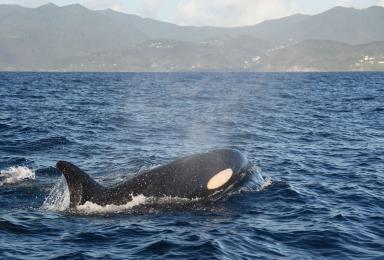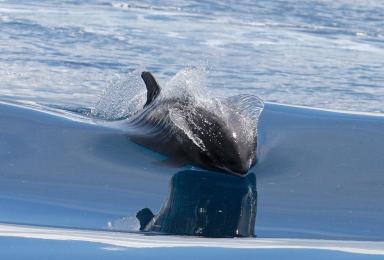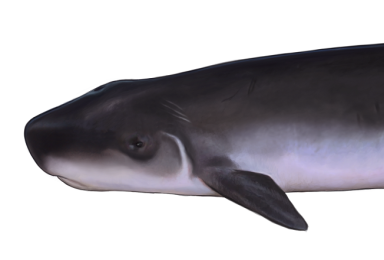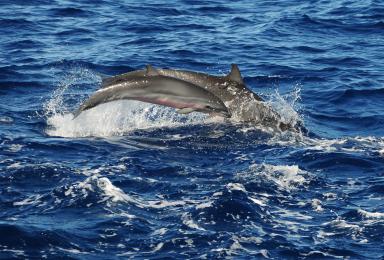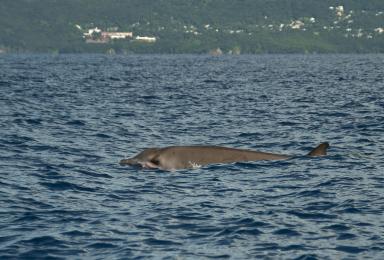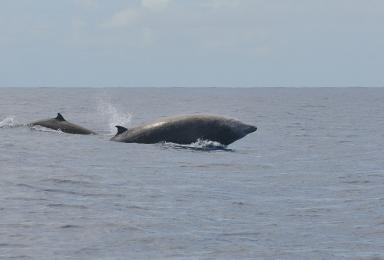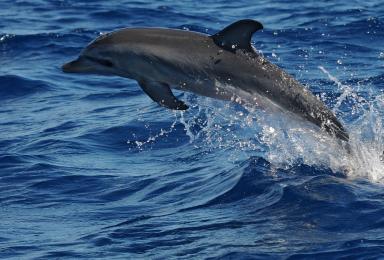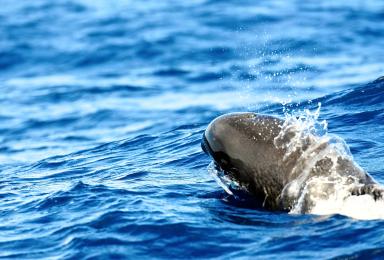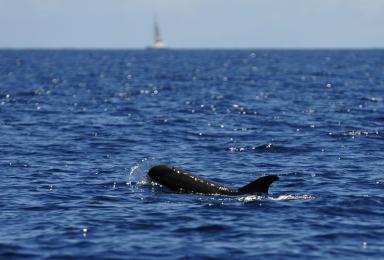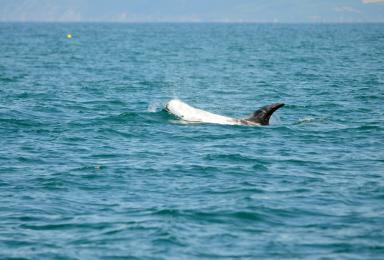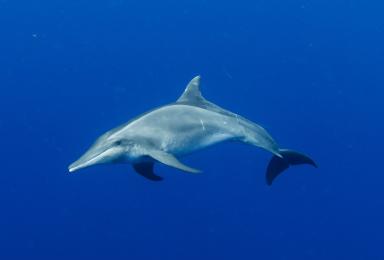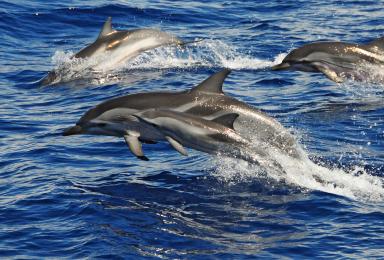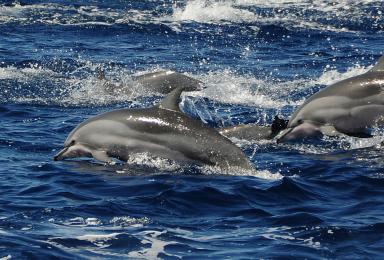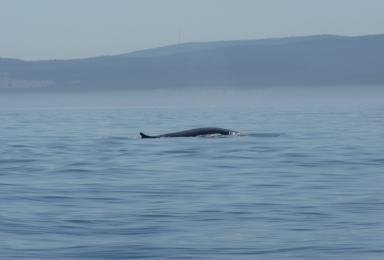The species of the Sanctuary
About thirty species of cetaceans frequent the waters of the Agoa Sanctuary. That is a third of the number of species in the world! Some are resident like the Pantropical Spotted Dolphin (Stenella attenuata), others come to our warm waters for part of the year to breed like the Humpback Whale (Megaptera novaeangliae).
Cetaceans are marine mammals, which means that they nurse their young, like humans.
There are two suborders of cetaceans: odontocetes, those with teeth (like dolphins), and mysticetes, which have a baleen (like the Humpback Whale), a kind of filter that allows them to feed on very small prey.
We can differentiate them by the blowholes located on the top of their head which allow them to breathe. The odontocetes have a single blowhole (only one nostril) whereas the mysticetes have a double blowhole (two nostrils). The spout that we observe on the surface results from the expulsion of air on rising to the surface after holding its breath.
You can see the difference between a single and a double blowhole in the pictures opposite.
Focus on... echolocation
The special powers of toothed cetaceans
Odontocetes have developed a particular ability, called echolocation, in common with certain terrestrial animals living in the dark, such as bats.
Echolocation is a means of locating obstacles and prey through the emission of ultrasound, sound waves inaudible to humans. These waves are emitted by small resonant cavities, then concentrated and directed by the melon (the bump on their head). The waves will hit any obstacles (the surrounding area and other animals) and be sent back as an echo received in their jaw bones, then transmitted to the brain, which analyses them. The cetacean will thus be able to obtain the position and distance of an obstacle and identify a prey and know its speed of movement (according to the number, intensity and speed of the echoes received). Echolocation allows cetaceans to complement visual information by providing a real 3D map of their environment.
Humans also use echolocation on boats (radar) and also in medical imaging (ultrasound).
Listen to Magali explaining how echolocation works and how cetaceans use it.
Listen below to echolocation clicks of pilot whales, sperm whales, bottlenose dolphins and pantropical spotted dolphins.
The ecological roles of cetaceans
Cetaceans are found in all oceans, from coastal areas to deep seabeds. Depending on their size, feeding strategy or movements, they play important ecological roles.
- Whales act as a pump that recirculates organic matter from prey sunken in the depths and made available to microplankton via their faeces. This material, rich in phosphate (700 times higher level than in sea water) and nitrogen, is essential to the primary production of the marine ecosystem. It feeds the phytoplankton which has the distinctive characteristic of producing 50% of the oxygen of the planet and also absorbing 40% of the CO2 produced.
- In addition, whales feed in some areas and then migrate to other areas to breed or give birth. This migration contributes to the geographical circulation of these nutrients, which are essential for microorganisms.
- By feeding on plankton, cetaceans accumulate CO2 in their bodies throughout their lives. The CO2 is transformed there and when they die and their remains sink to the bottom of the sea, they not only feed the necrophagous animals that live there, but above all they provide the CO2 that settles at the bottom of the sea. Before the decline of their populations, the potential of cetaceans to sequester carbon was equivalent to a forest area larger than Argentina. Human exploitation of cetaceans has reduced this potential by 96%. Working to conserve these animals and no longer hunting them contributes to maintaining carbon in the oceans and no longer releasing it into the atmosphere.
According to a study carried out by the International Monetary Fund and the Great Whale Conservancy:
When a whale dies and sinks to the bottom of the ocean, it traps 33 tons of CO2 on average, removing this carbon from the atmosphere for centuries.
- Marine mammals are at the top of the food chain. By feeding, these super-predators regulate the populations of smaller species. Without them, some species would rapidly expand at the expense of other animals and plants. The whole ecosystem could be turned upside down and this could lead to the disappearance of some of them.
- Whales, and more generally cetaceans, are considered to be sentinel species, indicators of the health of marine environments because they are found in all oceans, from coastal areas to the deep sea. A decline in their population can be indicative of a degradation of their ecosystem. For example, a population leaving a feeding area that it usually frequents will cause us to question the state of its fish stocks (Is intensive fishing carried out in this area? Has another predator come to compete?) A disease developed in a given population could be the consequence of a pollution of the environment, the abandonment of a breeding ground or the consequence of disturbance.
-
Cetaceans are also said to be umbrella species. By protecting them, we not only ensure the maintenance of their populations, but also the conservation of other species that depend on the same ecosystem.
Focus on... the evolution of cetaceans, from the land to the sea.
Before living in water, cetaceans lived on land. Etienne will make you discover what they looked like and how they reached the ocean.
Emblematic extinct species
In the past, the French West Indies not only had cetaceans but also other marine mammals which are now extinct. These include the Antillean Manatee (Trichechus manatus manatus) and the Caribbean Monk Seal (Monachus tropicalis). Only cetaceans are still found in our waters.
Magali explains the reasons for the extinction of the Caribbean monk seal and the Caribbean manatee.
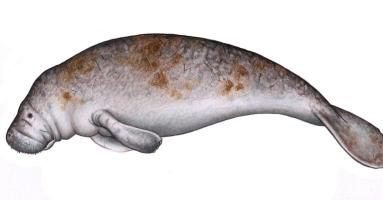
Antillean Manatee
Listed as vulnerable at world level, it is considered to have disappeared from the French West Indies since 1988. It has been a victim of human expansion which has reduced its habitat and generated injuries (boat propellers, fishing nets...). It was hunted and a victim of human pollution.

Caribbean Monk Seal
Listed as extinct since 2008, its extinction was caused by hunting in the 18th and 19th centuries. Its fat was highly prized for the manufacture of by-products. Overfishing was also a cause of its disappearance.
Focus on... the Red List of threatened species
Solène explains the interest of the IUCN Red List and speaks about threatened species in the French West Indies.
To find out more about the IUCN Red List, click on the documents below.

La Liste rouge des espèces menacées
Qu'est ce que la Liste rouge de l'UICN et à quoi sert-elle ?


